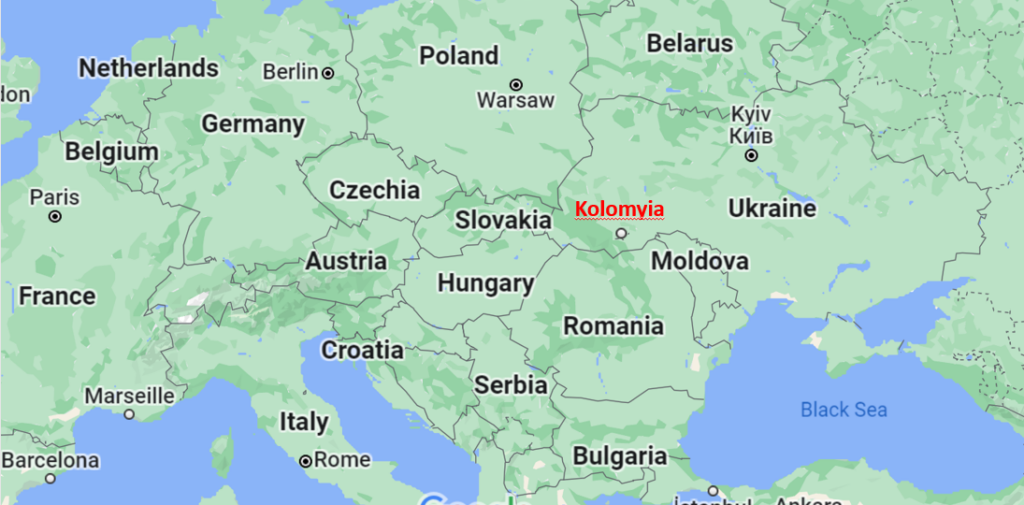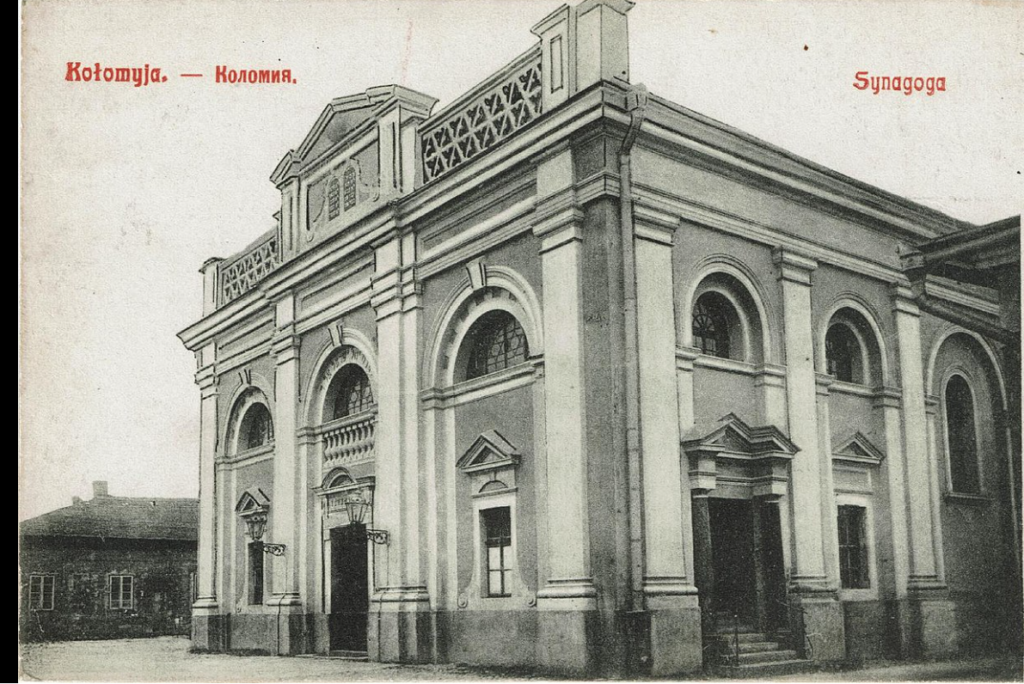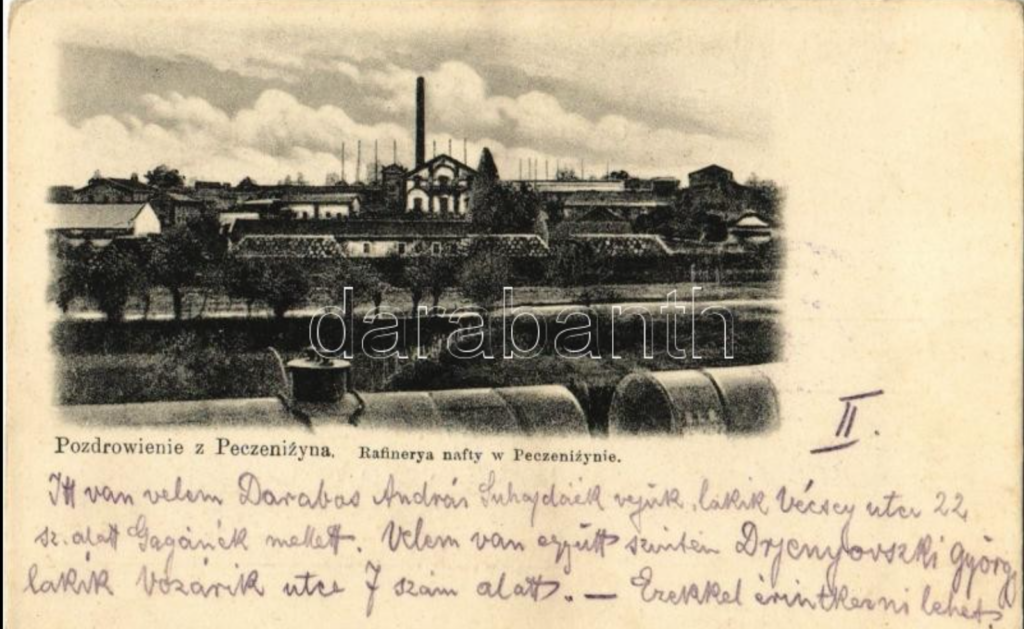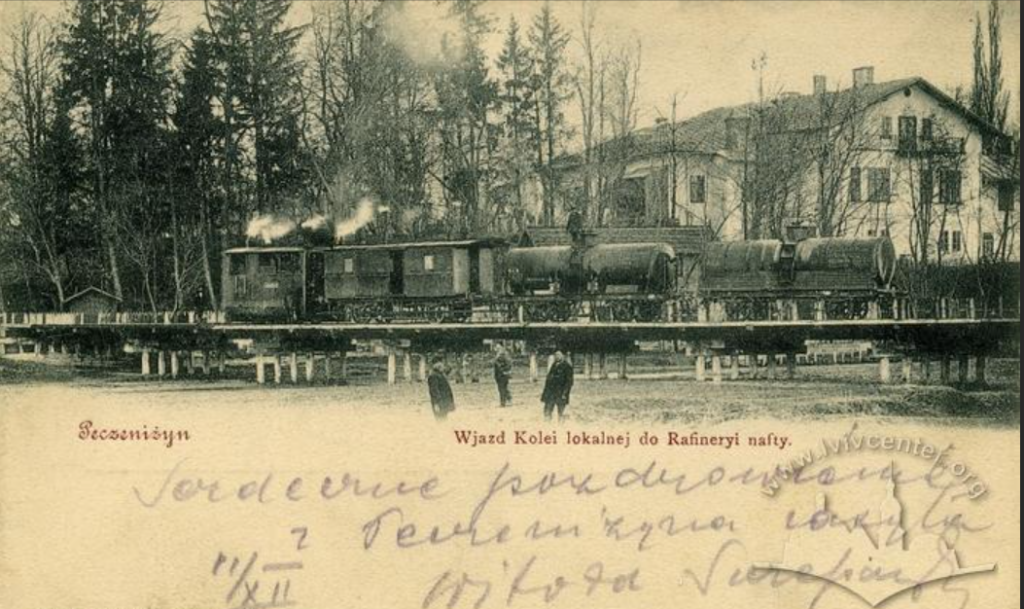Background
The Kramer family, comprised of five brothers and their parents who arrived in the United States in the early 1900s were originally called Krauthamer (less often Krauthammer). They were part of a larger family extending by marriage to the Rosenkranz, Romer and Gugig families and others. These families lived during the 1800’s in an area of what is today western Ukraine, in the oblast (a state-like division) of Ivano-Frankivsk.
The largest city in this immediate area then and today is Kolomyia also Kolomyya. The extended family resided in several nearby towns particularly Pechenizhyn (Krauthamer), Hvizdets (Rosenkranz), and Kosow, also Kossow/Kosiv (Romer). The present-day map below shows the location of these towns.


From Google Maps
History
The history of the Kolomyia region is quite complex with ruling countries and administrative districts shifting over the centuries. When Jews began to settle in area around 1500 it was ruled by the Kingdom of Poland. The Jewish community was decimated in 1648-1649 Chmielnicki uprising, in which as many as 20,000 were murdered by Cossacks, but Jewish life in Kolomyia recovered rapidly. After the First Partition of Poland in 1772, Austria (Austria-Hungary after 1867) under the Hapsburg dynasty came to control the Kolomyia area, which became part of an administrative district called Galicia (initially Galicia-Lodomeria), and held sway until World War 1. After the war, with the collapse of the Austria-Hungarian Empire in 1918 followed by a period of instability, Poland assumed control of the region which became part of the Stanislawow province. At the outset of World War 2 in 1939, the Russians invaded the region followed by Nazi Germany in 1941 leading to the end of the Jewish community in the region.
For much of the time that the Krauthamers and related families resided there, the administrative region was called Galicia. The map below shows modern Europe overlaid with Galicia (yellow stripes), then part of the Austro-Hungarian Empire, as well as other empires of the late 19th century.

From: https://www.wikitree.com/wiki/Space:Kingdom_of_Galicia_and_Lodomeria
A Brief Jewish History of Galicia
At the time of annexation and formation of Galicia by the Hapsburgs in 1772, the Jewish population stood at just over 5% of the total population. By 1857 it had increased to 9.6%. In 1910, several years before the outbreak of World War 1, the number of Jews stood at 872,000 or 10.9% of the population. The legal status of the Jews evolved after the founding of Galicia. The Hapsburg emperor Joseph II promulgated the Edict of Toleration in 1789, which abolished much of the previous Jewish religious hierarchy and gave the Jewish population more rights and obligation of the general population. The Edict permitted Jews to vote and hold office, own property and work in crafts, industry and agriculture but that Jews adopt surnames, send their children to German speaking schools and required them to enlist for military service. After the death of Joseph II, there was a gradual regression of Jewish privileges which lasted until the accession of Emperor Franz Joseph to the throne in 1848. Franz Joseph gradually removed restrictions on the Jews who were granted equal rights in 1867. The late 19th and early 20th century were thus a time of relative tranquility for the Galician Jews. Though most were tradesmen and lived modestly, a disproportionate of Galician professionals were Jewish. Religiously, the forces of Orthodoxy, in particular Hasidism competed with a more liberal constituency that promoted assimilation with the German and Polish populations and encouraged Jewish nationalism and the initial stirrings of Zionism.
Individual cities and towns relevant to the Kramer family
Kolomyia
As its largest city, Kolomyia (formerly Kolomea) was the economic hub of the region. A Jewish population increased considerably through the 1800s, comprising approximately half of the total population (details below) Jews contributed greatly to the economic life of the city, including flour mills, tailoring, brick production, weaving of prayer shawls (tallaisim) with contributions to the lumber industry being noteworthy. The size and influence of the Jewish population translated to political power in the form of several Jews who were elected to local political posts and to the Austrian parliament. While the city was stronghold as a Hasidism, in later years more progressive influences took hold including labor activism and Zionism. The Russia occupation during World War 1 led to the departure of many Jews. After Poland assumed control in 1919, while cultural and religious life remained robust, the economic situation progressively worsened.

From: https://www.jgaliciabukovina.net/110697/community/kolomea

From: https://www.jewishgen.org/yizkor/kolomyya/kol013.html

Pechenizhyn (Krauthamer family)
Pechenizhyn (also Peczenizyn) is a small town 7 miles (12 km) west of Kolomyia. It is known that the Jewish population dates at least to the 1700’s because a wooden synagogue replete with striking wall paintings with erected at that time. Growth of the city was promoted in the late 1800’s by the discovery of oil which led to the construction of a train route between Kolomyia and Pechenizhyn. Community Rabbis in the late 19th and early 20th centuries were members of the Hager family.

https://commons.wikimedia.org/wiki/File:Peczenizyn_(Pechenizhyn),_wooden_synagogue_-01.jpg


Pechenizhyn oil refinery From: https://www.darabanth.com/
www.lvivcenter.org

From: http://jgaliciabukovina.net/110745/community/pechenezhin
Kosiv (Romer family)
The small town of Kosiv (also Kossov) lies 21 miles (35 km) south of Kolomyia. The first Jews of Kosiv were said to have settled around 1600. The town’s owners, Polish nobility encouraged Jewish settlement in the salt industry, milling and taverns. A spa was established in the late 1800’s and the town developed a reputation as a center for natural medicine. In the late 1700’s the town became a center of Hasidism and the Kosover dynasty and including a disciple of the Baal Shem Tov (Besht), the founder of the Hasidic movement. Kabbalistic groups soon emerged in Kosiv and the nearby town of Kuty. Because of the strong orthodox influence in Kosiv, Zionist influenced arrived relatively late.

https://www.jgaliciabukovina.net/110731/community/kosov

Kosiv market. From https://shtetlroutes.eu/en/kosv-putvnik/

From: https://historicsynagogueseurope.org/browser.php?mode=set&id=7891
Hvizdets (Rosenkranz family)
The small town of Hvizdets (previously Gwozdziec) is located 12 miles (19 km) east northeast of Kolomyia. Jews in Hvizdets and neighboring towns of Czernelica and Horodenka were engaged in trading grain, wood and salt, owned taverns and breweries and were involved in wine-making. The community was considered relatively prosperous. By the mid-1800’s similar to other towns, Hasidism exerted a strong influence. Hvizdets was famous for its ornate wooden synagogue which after near three centuries of use was destroyed by the Nazis.

https://jgaliciabukovina.net/110751/community/gvozdets


Hvizdets wooden synagogue. From: https://cja.huji.ac.il/wpc/browser.php?mode=set&id=22151